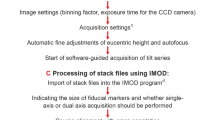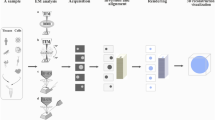Abstract
Electron tomography provides three-dimensional structural information about supramolecular assemblies and organelles in a cellular context, but image degradation, caused by scattering of transmitted electrons, limits applicability in specimens thicker than 300 nm. We found that scanning transmission electron tomography of 1,000-nm-thick samples using axial detection provided resolution comparable to that of conventional electron tomography. We demonstrated the method by reconstructing a human erythrocyte infected with the malaria parasite Plasmodium falciparum.



Similar content being viewed by others
References
Baumeister, W. FEBS Lett. 579, 933–937 (2005).
Hoenger, A. & McIntosh, J.R. Curr. Opin. Cell Biol. 21, 89–96 (2009).
Aoyama, K., Takagi, T., Hirase, A. & Miyazawa, A. Ultramicroscopy 109, 70–80 (2008).
Bannister, L.H., Hopkins, J.M., Fowler, R.E., Krishna, S. & Mitchell, G.H. Parasitol. Today 16, 427–433 (2000).
Henderson, G.P., Gan, L. & Jensen, G.J. PLoS One 2, e749 (2007).
Marsh, B.J. Methods Cell Biol. 79, 193–220 (2007).
Bouwer, J.C. et al. J. Struct. Biol. 148, 297–306 (2004).
Ziese, U., Kübel, C., Verkleij, A.J. & Koster, A.J. J. Struct. Biol. 138, 58–62 (2002).
Batson, P.E., Dellby, N. & Krivanek, O.L. Nature 418, 617–620 (2002).
Hyun, J.K., Ercius, P. & Muller, D.A. Ultramicroscopy 109, 1–7 (2008).
Gentsch, P., Gilde, H. & Reimer, L. J. Microsc. 100, 81–92 (1974).
Sousa, A.A., Hohmann-Marriott, M.F., Zhang, G. & Leapman, R.D. Ultramicroscopy 109, 213–221 (2009).
van Dooren, G.G. et al. Mol. Microbiol. 57, 405–419 (2005).
Marsh, B.J., Mastronarde, D.N., Buttle, K.F., Howell, K.E. & McIntosh, J.R. Proc. Natl. Acad. Sci. USA 98, 2399–2406 (2001).
Höög, J.L. et al. Dev. Cell 12, 349–361 (2007).
Glushakova, S. et al. Cell. Microbiol. 11, 95–105 (2009).
Reimer, L. & Ross-Messemer, M. Ultramicroscopy 21, 385–388 (1987).
Weyland, M. & Muller, D.A. Nanosolutions 1, 24–35 (2005).
McEwen, B.F. & Marko, M. J. Histochem. Cytochem. 49, 553–564 (2001).
Koster, A.J. et al. J. Struct. Biol. 120, 276–308 (1997).
Kremer, J.R., Mastronarde, D.N. & McIntosh, J.R. J. Struct. Biol. 116, 71–76 (1996).
Acknowledgements
This work was supported by the Intramural Research Programs of the National Institute of Biomedical Imaging and Bioengineering, and the Eunice Kennedy Shriver National Institute of Child Health and Human Development of the National Institutes of Health. We thank T. Reese for help with the freeze-substitution technique. M.F.H.-M. acknowledges support through the Joint National Institute of Standards and Technology–National Institute of Biomedical Imaging and Bioengineering Postdoctoral Associateship program of the US National Research Council.
Author information
Authors and Affiliations
Contributions
M.F.H.-M. and A.A.S. conceived the project, designed and performed experiments, processed and analyzed data and wrote the paper. A.A.A. processed and analyzed data. G.Z. prepared specimens for electron microscopy. S.G. and J.Z. provided samples of P. falciparum–infected erythrocytes, analyzed data and contributed to writing the paper. R.D.L. coordinated the project, designed experiments, analyzed data and wrote the paper.
Corresponding authors
Supplementary information
Supplementary Text and Figures
Supplementary Figures 1–10 and Supplementary Discussion 1–2 (PDF 12187 kb)
Rights and permissions
About this article
Cite this article
Hohmann-Marriott, M., Sousa, A., Azari, A. et al. Nanoscale 3D cellular imaging by axial scanning transmission electron tomography. Nat Methods 6, 729–731 (2009). https://doi.org/10.1038/nmeth.1367
Received:
Accepted:
Published:
Issue Date:
DOI: https://doi.org/10.1038/nmeth.1367
- Springer Nature America, Inc.
This article is cited by
-
Zika virus replication in glioblastoma cells: electron microscopic tomography shows 3D arrangement of endoplasmic reticulum, replication organelles, and viral ribonucleoproteins
Histochemistry and Cell Biology (2021)
-
Resolution and aberration correction in liquid cell transmission electron microscopy
Nature Reviews Materials (2018)
-
Magic number colloidal clusters as minimum free energy structures
Nature Communications (2018)
-
STEM tomography of high-pressure frozen and freeze-substituted cells: a comparison of image stacks obtained at 200 kV or 300 kV
Histochemistry and Cell Biology (2018)
-
PAR1 activation induces rapid changes in glutamate uptake and astrocyte morphology
Scientific Reports (2017)





